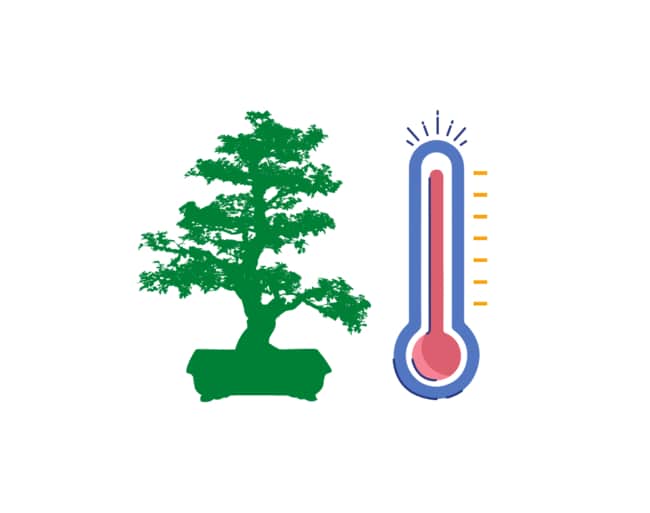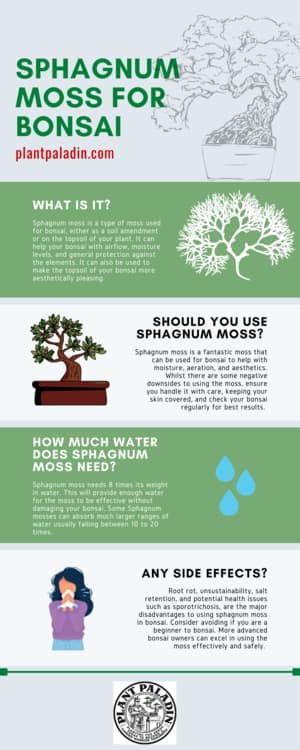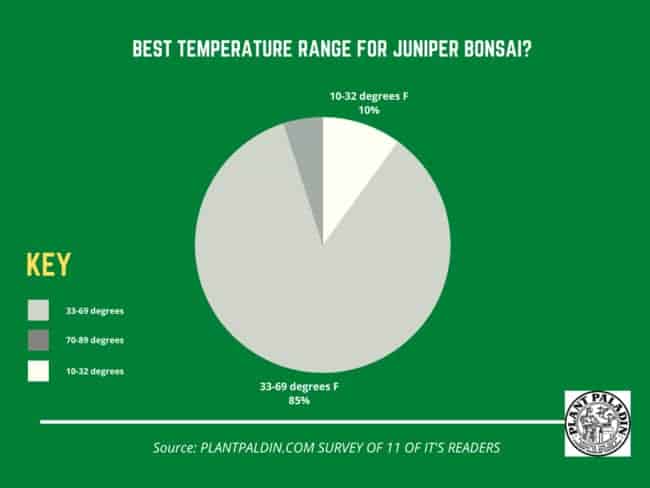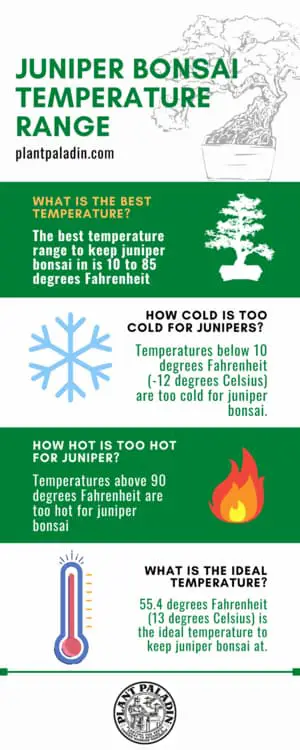This website is supported by its readers. If you click one of my links I may earn a commission. I am also a participant in the Amazon affiliates program and I will also earn a commission from qualified purchases.

One of the best bonsai trees I found as a beginner to get to grips with are Junipers. They are very forgiving, easy to manage, and have made a difference to my small bonsai collection. That being said, one of the challenges I’ve come across living in a relatively cold climate is the best temperature to keep these junipers at. So what is the ideal juniper bonsai temperature range?
The best temperature range to keep juniper bonsai in is 10 to 85 degrees Fahrenheit (-12 degrees to 29 degrees Celsius). Temperatures exceeding 90 degrees Fahrenheit (32 degrees C) will damage juniper bonsai and temperatures over 100 degrees Fahrenheit (37 degrees C) can be fatal.
So how do you care for junipers during extreme cold and extreme heat? And do all juniper bonsai species fall into this category? Keep reading to find out more.
Just a quick heads up, over the past three years of running Plantpaladin, hundreds of people have asked for product recommendations. As such, You can find my favorite indoor bonsai tree here (link takes you to Bonsaiboy), my favorite outdoor bonsai tree (link takes you to Bonsaiboy), or have a look at all the products I recommend here.
Juniper bonsai temperature range
If you were to ask me what the best bonsai tree species for an absolute beginner would be I would say a Chinese elm.
That being said a very close second would have to be a Juniper.
Not only are they incredibly forgiving, meaning it takes a lot of serious pruning to damage these trees, they are super versatile making any bonsai collection really pop.
What’s even better is as these trees are evergreens, their needles remain a nice green/red color throughout the year.
That being said, one of the issues I’ve had in the past living in a cold environment such as the UK is the temperature ranges juniper can survive in.
Best temperature ranges for juniper bonsai
With temperatures around the world fluctuating rapidly due to climate change, understanding the temperature ranges these plants can survive in is going to be incredibly important.
Luckily I’ve visited multiple garden centers, surveyed this blog’s readers, and asked them this very question.
I’ve also experienced keeping my juniper in particularly harsh summers in 2021 and particularly cold winters.
To summarize:
- The lowest temperature range you can keep a juniper bonsai at is 10 degrees Fahrenheit.
- This is -12 degrees Celsius.
- The highest temperature that is safe for a juniper bonsai is 85 degrees Fahrenheit.
- This is 29 degrees Celsius.
- The best temperature range to keep juniper bonsai in then would be between 10 degrees Fahrenheit to 85 degrees Fahrenheit.
- This would be -12 degrees to 29 degrees Celsius.
- A more realistic temperature range however would be away from the extremes ends of this scale.
- A range of 20 degrees Fahrenheit to 80 degrees Fahrenheit is the optimal temperature for your juniper bonsai to thrive.
- This is – 6 to 26 degrees celsius.
- Should junipers get higher than 90 degrees Fahrenheit (32 degrees Celsius) then juniper bonsai will start to show signs of damage.
- At temperatures of over 100 degrees Fahrenheit (37 degrees celsius) can prove fatal for juniper bonsai.
- If temperatures drop below 10 degrees Fahrenheit (-12 degrees Celsius) then juniper bonsai will need to be winterized.
- These figures are accurate for all species of juniper, including Japanese Garden Junipers or Green Mound Junipers.
Juniper bonsai temperature
To help further explain what happens to junipers at different temperature levels I’ve created a table that you can reference.
| Temperature |
Results |
| Below 10 degrees Fahrenheit
(-12 degrees Celsius) | At a temperature less than 10 degrees, juniper bonsai will freeze over, severely impacting its ability to pass nutrients through the tree. If left unchecked this will stunt growth and eventually kill your plant. Ensure you have drainage holes and permeable soil to ensure any excess water can drain easily to avoid mold or fungal infections. |
| 10 to 32 degrees Fahrenheit
(-12 to 0 degrees Celsius) | This temperature range is the lowest temperature range that juniper bonsai can survive at. Frost and ice may start to settle on your bonsai but its overall health will not be severely impacted during the winter months at these temperatures. |
| 32 to 69 degrees Fahrenheit
(0 to 25.5 degrees celsius) | The ideal temperature to keep juniper bonsai at. Not too hot but not too cold either. This temperature will allow for maximum growth and health – especially if kept outdoors. |
| 69 to 89 degrees Fahrenheit
(25.5 to 31.6 degrees Celsius) | The upper limit of temperature for juniper bonsai. Bonsai at this temperature will also have massive growth due to the increased photosynthesis and food available. Just ensure you check for dry soil and water regularly. Underwatering can be a problem. |
| 90 to 99 degrees Fahrenheit
(32 to 37 degrees Celsius) | Juniper Bonsai will start to have wilted leaves or drop leaves as a way to conserve energy. Leaves on your tree may also start to rust or turn yellow. At this stage, it is important to try and save the tree by keeping them indoors at a more appropriate temperature. |
| 100 degrees + Fahrenheit
(37.7 + degrees Celsius) | At temperatures of over 100 degrees, juniper bonsai will not be able to survive in this prolonged heat and will prove fatal. Ensure then that you keep in a cooler environment as soon as temperatures start to approach this limit. |
How hot is too hot for junipers
Temperatures above 90 degrees Fahrenheit are too hot for juniper bonsai. If kept at these temperatures, juniper bonsai will begin to dehydrate, wilt and shed its leaves, becoming inefficient at passing nutrients through the plant. Temperatures over 100 degrees Fahrenheit can be fatal.
The best method to keep juniper bonsai if you regularly get temperatures this high is to keep your bonsai in a greenhouse. You can then carefully manage and maintain the climate and temperature.
How cold is too cold for junipers?
Temperatures below 10 degrees Fahrenheit (-12 degrees Celsius) are too cold for juniper bonsai. At this temperature nutrients will not be able to pass through your plant easily, affecting plant health and growth. To avoid temperatures this low, create or invest in a bonsai cold frame.
What is the ideal temperature for juniper bonsai?
55.4 degrees Fahrenheit (13 degrees Celsius) is the ideal temperature to keep juniper bonsai at. This is cold enough so your plant won’t dry out, but warm enough that your juniper won’t freeze. A more realistic temperature range for juniper would be between 10 to 85 degrees Fahrenheit.
Why is temperature important when keeping juniper bonsai?
Whilst it’s rare that any of you reading this will hit the extreme temperatures that juniper bonsai are not able to survive in, it’s important to understand why temperature is important when keeping bonsai.
Most bonsai, including juniper, originate from countries like China, Japan, and South America.
As such these plants sometimes are not used to the temperatures where we grow them.
It’s important then, that we try to mimic the temperatures that these plants grow in with some tropical species, for example not being able to thrive in winter months.
What happens if you don’t match the temperature?
Failing to match the temperature or keeping your bonsai outside the temperature ranges in this post will stop essential functions of your plant such as nutrient flow, photosynthesis and make your bonsai more susceptible to things like leaves falling off, mold infections, or even bug infestations.
Luckily, however, for those of us living in western Europe or North America, Juniper bonsai are mild bonsai and pretty much match the natural temperatures most of our climates have.
How to maintain the temperature for juniper bonsai?
So now we know the best temperature ranges for juniper, how do you maintain juniper bonsai if you live in a climate that can have these extreme temperature changes?
In a word – greenhouses.
Bonsai greenhouses are fantastic options to help maintain the temperature of bonsai susceptible to changes in temperature, giving bonsai owners complete control of the environment without limiting the amount of light their trees receive.
Now bonsai greenhouses are relatively easy to set up so if you are interested in setting one up for your juniper bonsai – check out this post here.

Do junipers perform better in warm or cold temperature ranges?
Juniper bonsai thieves best when in mild temperatures and climates ranging from 10 degrees to 85 degrees Fahrenheit (-12 degrees to 29 degrees Celsius). Neither extremely hot nor extremely cold conditions will benefit juniper bonsai.
Juniper bonsai perform better when kept outdoors rather than indoors due to the light needs of these plants.
Will your climate impact your juniper bonsai temperature range?
So if you are in the process of buying a juniper, it can be frustrating to find out this information. Especially if you are unaware of how high or low the temperature of where you live gets.
Luckily the USA has a plant hardiness zone designed specifically to let you know which plants can survive living in which climates.
Other sources
Failing this I would have a look at the climate knowledge portal which has historic information on a country by country basis on the highs and lows on a year by year basis.
Take the average of the past five years and see if it is good for you to grow juniper for your climate.
For example, growing bonsai trees in Russia where the winter temperatures can get as low as -89.9 degrees Fahrenheit means you will have to winterize your bonsai during the cold months.
Do you need to winterize juniper bonsai?
If temperatures drop below 10 degrees Fahrenheit (-12 degrees Celsius) then winterizing your juniper bonsai will be essential. The best way this can be done is by using a bonsai cold frame or keeping your bonsai topsoil covered by a tarp, mulch, and outdoors.
Now winterizing a bonsai is a challenging topic, but luckily I’ve come up with a few posts below that can help with the process.
These include:
So check them out if where you live drops below 10 degrees during the winter months.
Should you keep juniper bonsai indoors?
Juniper bonsai should be kept outdoors as they are coniferous. This is because junipers require a lot of light, often between 4 to 8 hours during the summer growing months. Juniper bonsai however can be kept indoors for a few days at a time should outdoor temperatures become too extreme.
Whilst keeping your juniper bonsai indoors will give you the ability to completely manage the temperature the bonsai gets, keeping your bonsai outdoors just has a lot more added benefits outside of sunlight such as getting natural water or improves aeration and airflow.
It’s one of the reasons why some larger-sized juniper bonsai owners will opt to keep their bonsai planted in the ground.
How to care for juniper during warm temperatures
So if you live in a climate near the high end of the temperature ranges laid out in their post, there are a few things you can do to ensure your juniper has the best chance of success.
These include:
Ensure you don’t exceed 85 degrees
Whilst bonsai trees can survive up to 90 degrees, ensure you avoid keeping your bonsai outdoors should the temperature get above 85 degrees.
This is because a lot of thermometers have a few degrees of leeway meaning your bonsai might actually be burning before you even realize it.
Monitor your juniper for water
Easily the biggest challenge for junipers during warm temperatures is a lack of water. Ensure then that you touch the topsoil of your bonsai. If it is dry to the touch then water until the water drains.
I recommend checking your bonsai soil three times per day if you live in a warm climate to ensure your plant is getting enough water.
Avoid fertilizer
Whilst organic fertilizers should be fine, most fertilizers contain several harsh chemicals that take a lot of effort for your plant to break down at the best of times.
When the temperature is hot, your bonsai will go into a period of stress making it more difficult to break the fertilizer down, potentially damaging or even killing your juniper.
Avoid using chemical-based fertilizers during warm temperatures at all costs.
Invest in sphagnum moss
Sphagnum moss or any moss for that matter is fantastic at holding onto moisture.
As such during the summer months, this can be fantastic at providing your juniper moisture when desperately needed.
To find out more about how to apply this, check out this post on sphagnum moss here.

Keep your plants in the shade
Whilst junipers need between 4 to 8 hours of direct sunlight, in very warm temperatures this can potentially burn your plant leaves and cause them to wilt.
For best results, rotate your bonsai in between shade and sunlight to protect your juniper.
Check for signs of stress
Shriveled branches, dropping or wilted leaves, or brown or copper tinges to your juniper are surefire signs that your bonsai is stressed because of the hot temperature.
In a situation like this, I would recommend moving into a colder room in your house or better yet, creating a bonsai greenhouse where you can directly monitor and change the temperature directly.
After a few days, remove and place your bonsai back outside.
How to care for juniper during cold temperatures
Similar to above, if you live in a colder climate I would do the following:
Ensure temperatures don’t drop below 10 degrees Fahrenheit
At below 10 degrees, Fahrenheit or -12 Celsius, juniper bonsai will start to freeze, stopping the nutrient flow of your tree.
This will cause your plant to go into a state of shock and if not warmed up, eventually die.
During cold climates or the winter months, ensure you take note of the temperature and keep your bonsai inside if the temperature falls this low.
Ensure your bonsai gets enough light
Easily one of the biggest challenges when it comes to juniper bonsai is cold temperatures and lack of light.
If your bonsai lives in a cold space, likely, there is not a lot of light too.
As junipers require a lot of sunlight, consider investing in a led or UV light to mirror natural sunlight.
Whilst this won’t be as effective as the real thing, it can help during very cold temperatures such as harsh winters
Invest in a cold frame
Either building a cold frame from scratch or creating your own are two fantastic options.
Cold frames are just boxes that you keep your bonsai in as a way of maintaining their temperature.
They usually have a few walls and some form of insulation – I found the best place to keep these is in a garage.
Winterize your bonsai
If you live in a cold temperature year-round but have planted your bonsai in the ground, or just want to keep your bonsai outdoors, one of the best things you can do is winterize your bonsai.
Covering the topsoil of your bonsai in mulch, debris or leaves is the best option.
This will prevent those areas from dehydrating due to the cold air whilst keeping the roots of your bonsai warm.
What do the experts say?
Finally, I didn’t just want to give my advice on the topic of the best temperature ranges for bones and so got in touch with my local botanical garden center – here is what they said
“Anything above 30 degrees Celsius or 0 degrees is where we start to pack up our junipers – on the whole, though they are very reliable trees”
I also had a look at one of Bonsai Empires videos to see their thoughts on bonsai temperature and there were their thoughts:
“The Juniper is frost hardy but should be protected from strong frost of around 15 degrees Fahrenheit or -10 degrees celsius”
Finally, I also did a survey asking around 20 readers on plant paladin their thoughts on the best temperature range for juniper bonsai and this was their response:

My top picks for the gear you will need!
So like I mentioned earlier, over the past three years of running PlantPaladin, hundreds of people have asked me for my recommendations on the best bonsai gear on the market.
Having spent thousands of dollars on bonsai items these past few years and tested at least 100 bonsai-specific products, I’ve listed my favorite products below – All of which I highly recommend and think you can get great value.
They can purchase directly by clicking the link to take them to Amazon.
Bonsai Tool Set: One of the significant challenges I’ve had is finding a toolset that was not only durable but didn’t break the bank. SOLIGT has recently developed a fantastic bonsai tool set that covers all the tools you need to trim, prune, and repot your trees. – You can grab it here.
Complete Bonsai Set: Many of you will want to grow your bonsai trees entirely from scratch, but finding the varicose seeds, pots, and other items in one place can be challenging. Leaves and Sole then have created a complete bonsai set that I’ve personally used that ticks all the boxes. You can grab it here.
Bonsai wire: The number of times I’ve run out of wire for my bonsai or purchased cheap bonsai wire that doesn’t do the job is embarrassing for me to admit. After a lot of trial and error, I found that using Hotop’s aluminum bonsai wire is one of the best options on the market. This can easily be used for both indoor and outdoor bonsai. You can grab it here.
This post was written by Fehed Nicass who has been passionate about bonsai for over 2 years.

